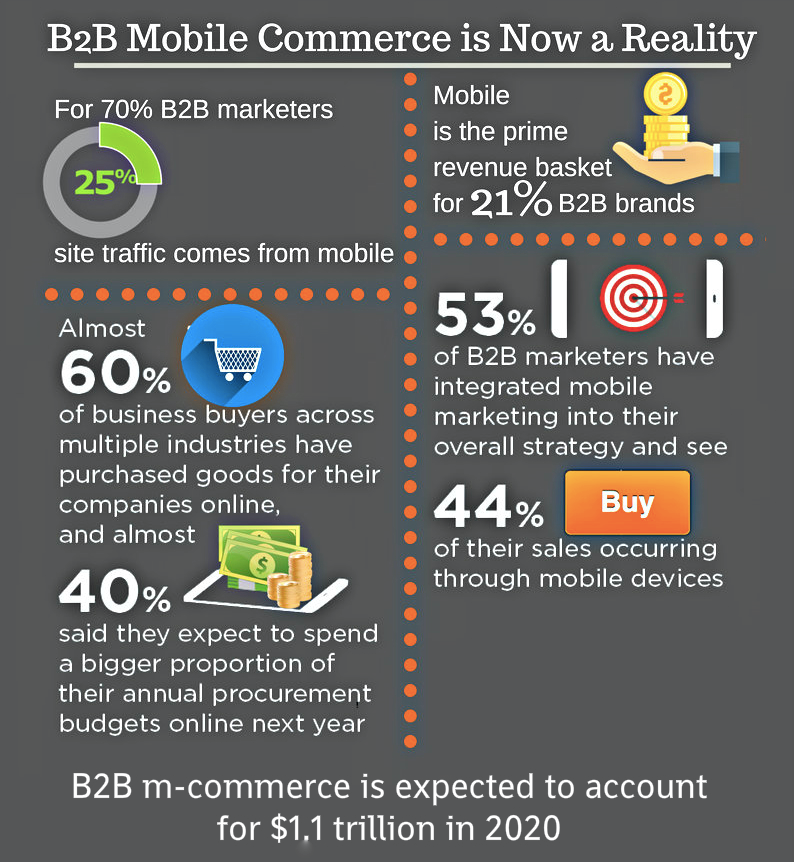(This is a guest post from our friends over at Quick eSelling, a cutting-edge Mobile eCommerce solution for B2B & B2C sellers.)
Today’s B2B customers are emulating B2C trends and transitioning their buying into online and mobile environments. There is a major shift from traditional activity of exploring print catalogs and talking to sales representatives, to starting the digital process by performing online searches on mobile devices. This is reshaping the B2B buyer journey.
“Worldwide B2B e-commerce will reach $6.7 trillion by 2020 and majority of these transactions will happen on Mobile” Forbes

B2B Mobile Commerce
Mobile e-commerce has become part of everyday life and most of the people engaged in B2B industry are already using it for B2C. For B2B businesses, mobile app is a self-service sales channel which offers advantage of connecting with their buyers and solving one of the biggest problem in sales: the decreasing performance and increasing cost of sales representatives.
The new age B2B buyers having decision making powers are around 35 years age. Nearly 75% of B2B buyers prefer buying online instead of interacting with sales reps and mobile commerce sales are growing at double the speed of B2C ecommerce.
Challenges for Mobile Commerce in B2B
There are several challenges resulting in slow growth of B2B Mobile e-commerce. From Buyers perspective, B2C like experience in B2B mobile apps with easy checkout process, quick re-ordering and in app tools for communication with seller to negotiate price are must have features. They also wish to have their communications & transaction history available on their fingertips through Apps.
From Seller’s perspective, keeping price and inventory updated on their e-commerce store is one of the challenge along with the cost of development. An average cost of mobile app development could be anywhere in range of $50K to $300K, several months of development time and additional annual cost for maintenance. There is a very high financial risk for most of the sellers in adopting B2B Mobile e-commerce.
Benefits of Mobile App in B2B:
A personalized experience while using the App is one of the biggest benefit of Mobile e-commerce. When buyer lands on home page of the app, they see products which they frequently order along with re-order options. With native features like finger print scans and face recognitions, a mobile app offers quick access to view order status and transaction history in mobile app.
For supplier, Push notifications are one of the most impactful marketing tools available today in the digital world. By sending regular push notifications, sellers can easily engage buyers with new products and offers. This makes it easy for seller to re-engage buyers and increase sales.
Many wholesalers & distributors are opening multi-location cash-and-carry stores. As B2B buyers are always short of time, by offering inbuilt GPS feature to track nearby pickup location, a B2B mobile app offers the convenience to order-on-go and collect their order in similar way as drive through concept works in B2C.
Trying to replicate the Native Mobile App experience on mobile responsive website is a near to impossible task and sellers should not try to fight for it.
Technology & Trends
To overcome these challenges, there are ready to use e-commerce Mobile app platforms, which are offering free native apps to help B2B businesses get started with Mobile e-commerce journey at zero capital investments. These platforms offer native apps within minutes and are easy to use through backend CRM. They also offer integration with various ERP, POS, Accounting software’s for inventory and price synchronizations.
The way, these new start-ups are making life easier for B2B sellers, most of the non-tech savvy wholesalers and retailers have already started shifting to a mobile-first or mobile only strategy. These sellers are reaping benefits of 24/7 connectivity with their customer through apps while ditching the legacy problems of relying only on sales reps.
Key Takeaway
B2B mobile commerce brings tremendous opportunity for B2B buyers and sellers. Buyers & sellers are looking for easy way to stay connected. With increasing numbers of people shopping on mobile devices, there is immediate need for B2B sellers to offer same m-commerce experience as buyers are used to on B2C platforms. By opening a new channel of shopping for buyers, most of the manufacturers, wholesalers and distributors can offer value to their customers. Mobile e-commerce is no more a hype, it has already arrived.
B2B companies that want to stay ahead in their business must reshape their sales strategies as having sales reps and a B2B ecommerce site is not enough. One must have a native B2B ecommerce mobile app to remain competitive.
About the Author
Saket Singhi, MD

Saket Singhi is an entrepreneur who established JVS Group: a Research based Clinical Software Solution company in 2002. He successfully took JVS Group from a start-up to one of the top 5 Healthcare IT companies in India. He Co-founded Quick eSelling in 2015 with focus on providing cutting-edge Mobile eCommerce solution for B2B & B2C sellers. He has 16 years of expertise to incubate and build teams, resolve business issues quickly and leverage existing investments to develop new business solutions with big results at minimal investment in Healthcare and eCommerce domain.
LinkedIn: https://in.linkedin.com/in/saketsinghi
Twitter: https://twitter.com/saketsinghi







[…] With increased usage of mobile apps, the mobile shopping share will keep on swelling. Not only B2C, B2B mobile ecommerce is also getting bigger and industry is expected to 1.1 trillion in […]
[…] With increased usage of mobile apps, the mobile shopping share will keep on swelling. Not only B2C, B2B mobile ecommerce is also getting bigger and industry is expected to 1.1 trillion in […]
[…] With increased usage of mobile apps, the mobile shopping share will keep on swelling. Not only B2C, B2B mobile ecommerce is also getting bigger and industry is expected to 1.1 trillion in […]
[…] With increased usage of mobile apps, the mobile shopping share will keep on swelling. Not only B2C, B2B mobile ecommerce is also getting bigger and industry is expected to 1.1 trillion in […]
[…] intuitive recommendations, and easier ordering experiences. A year ago B2B eCommerce was the primary revenue source for over 21% of B2B businesses. Now, mobile customers interested in making purchases are flooding […]
[…] 21% of B2B businesses, eCommerce is their primary revenue channel and B2B marketers that integrate mobile in their strategy are being rewarded […]